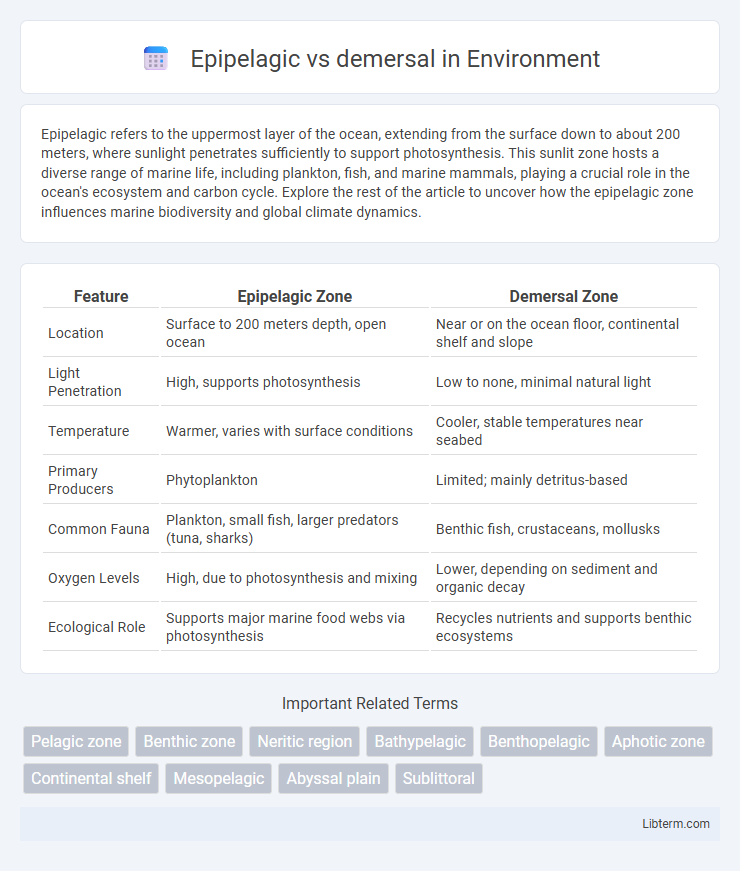Epipelagic refers to the uppermost layer of the ocean, extending from the surface down to about 200 meters, where sunlight penetrates sufficiently to support photosynthesis. This sunlit zone hosts a diverse range of marine life, including plankton, fish, and marine mammals, playing a crucial role in the ocean's ecosystem and carbon cycle. Explore the rest of the article to uncover how the epipelagic zone influences marine biodiversity and global climate dynamics.
Table of Comparison
| Feature | Epipelagic Zone | Demersal Zone |
|---|---|---|
| Location | Surface to 200 meters depth, open ocean | Near or on the ocean floor, continental shelf and slope |
| Light Penetration | High, supports photosynthesis | Low to none, minimal natural light |
| Temperature | Warmer, varies with surface conditions | Cooler, stable temperatures near seabed |
| Primary Producers | Phytoplankton | Limited; mainly detritus-based |
| Common Fauna | Plankton, small fish, larger predators (tuna, sharks) | Benthic fish, crustaceans, mollusks |
| Oxygen Levels | High, due to photosynthesis and mixing | Lower, depending on sediment and organic decay |
| Ecological Role | Supports major marine food webs via photosynthesis | Recycles nutrients and supports benthic ecosystems |
Introduction to Epipelagic and Demersal Zones
The epipelagic zone, extending from the surface to about 200 meters depth, is characterized by abundant sunlight, enabling photosynthesis and supporting diverse marine life including plankton, fish, and marine mammals. In contrast, the demersal zone lies just above the seafloor, where organisms such as bottom-dwelling fish and invertebrates thrive in low-light conditions with limited primary production. These zones differ fundamentally in light exposure, habitat structure, and biological communities, influencing the ecological dynamics and adaptations of the resident species.
Defining Epipelagic and Demersal Environments
Epipelagic environments refer to the upper layer of the ocean, extending from the surface down to about 200 meters, where sunlight penetration supports photosynthesis and abundant marine life. Demersal environments are found near or on the seabed, typically below the epipelagic zone, characterized by organisms adapted to living close to or on the ocean floor. The epipelagic zone hosts free-swimming pelagic species, while demersal zones contain bottom-dwelling fauna and fish associated with benthic habitats.
Key Physical Characteristics
Epipelagic species inhabit the upper 200 meters of the ocean, characterized by abundant sunlight, which supports photosynthesis and higher oxygen levels, resulting in streamlined bodies adapted for fast swimming and buoyancy control. Demersal species live near or on the seafloor, often exhibiting flattened bodies, camouflaged coloration, and specialized fins for stability and movement across substrates in low-light, high-pressure environments. The stark contrast in light availability, pressure, and habitat structure drives distinct morphological adaptations between epipelagic and demersal marine organisms.
Light Availability and Temperature Differences
Epipelagic zones receive abundant sunlight, supporting photosynthesis with temperatures ranging from 20degC to 25degC, fostering diverse marine life near the ocean surface. Demersal zones lie deeper with significantly reduced light penetration, often in complete darkness, and exhibit stable, cooler temperatures typically between 4degC and 10degC. These variations in light availability and temperature critically influence the distribution, behavior, and physiology of epipelagic versus demersal organisms.
Primary Species in Each Zone
The epipelagic zone primarily hosts species like tuna, mackerel, and sardines, which thrive in well-lit surface waters rich in plankton. In contrast, the demersal zone is dominated by bottom-dwelling species such as cod, haddock, and flounder, adapted to life near or on the ocean floor. These distinct habitats support different primary species due to variations in light, pressure, and food availability.
Feeding Strategies and Diet
Epipelagic fish primarily feed on plankton, small fish, and zooplankton, utilizing filter feeding or active hunting in well-lit surface waters. Demersal fish rely on benthic organisms such as crustaceans, mollusks, and detritus found near or on the ocean floor, employing bottom-feeding techniques and ambush predation. These differing feeding strategies reflect adaptations to their respective habitats, with epipelagic species exploiting open water resources and demersal species specialized for life close to the seabed.
Adaptations to Environmental Challenges
Epipelagic fish exhibit adaptations such as streamlined bodies and efficient gill structures to optimize oxygen intake in well-lit, oxygen-rich surface waters. Demersal species possess camouflaged coloration and specialized sensory organs to navigate low-light, high-pressure environments near the seafloor. Both groups demonstrate physiological adaptations like buoyancy regulation, either through swim bladders or lipid storage, to maintain stability in their respective ecological niches.
Roles in Marine Ecosystems
Epipelagic species inhabit the sunlit surface waters and are primary contributors to oceanic photosynthesis and carbon cycling, supporting a diverse food web. Demersal species live near or on the ocean floor, playing crucial roles in nutrient recycling, sediment mixing, and serving as prey for benthic and pelagic predators. Together, these organisms maintain ecosystem balance by linking surface and benthic food chains and facilitating energy transfer across marine habitats.
Human Impact and Conservation Concerns
Epipelagic fish, inhabiting the upper ocean layers, face threats from overfishing and habitat disruption due to commercial fishing and pollution, impacting both their populations and marine food webs. Demersal species, dwelling near the seabed, are vulnerable to bottom trawling, habitat degradation, and sediment disturbance, leading to significant biodiversity loss and altered ecosystem dynamics. Conservation concerns emphasize the need for sustainable fishing practices, marine protected areas, and pollution control to safeguard both epipelagic and demersal communities and maintain oceanic ecological balance.
Conclusion: Comparing Epipelagic vs Demersal Life
Epipelagic species inhabit the upper 200 meters of the ocean, relying on sunlight for photosynthesis-based food chains, while demersal species live near the seabed, often depending on nutrient-rich sediments for sustenance. The distinct adaptations between epipelagic and demersal organisms reflect their unique ecological niches, with epipelagic species optimized for open-water swimming and demersal species specialized for benthic environments. Understanding these differences enhances marine biodiversity conservation and resource management strategies.
Epipelagic Infographic

 libterm.com
libterm.com